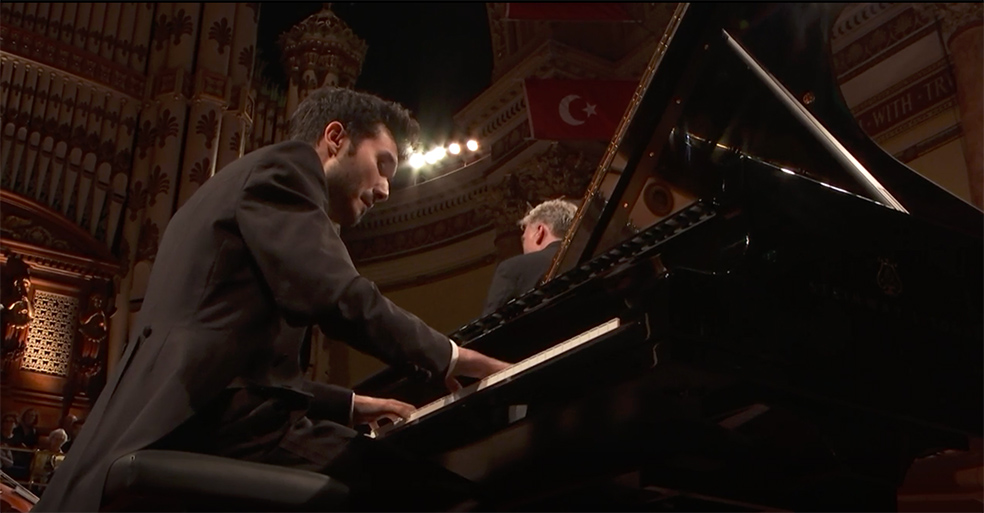The Istanbul Recitals series continued on February 14 with a concert by violinist Soyoung Yoon (photo: soyoungyoon.com) and pianist Mario Häring (photo: Stephan-Röhl) at The Seed in Emirgan. Like last month’s recital by the cellist Alexander Chaushian, this one featured a stringed instrument – though this time with piano accompaniment. Throughout the first half, Mr Häring accompanied Ms Yoon on the piano; in the second, he played a Beethoven sonata before the violinist reappeared for the final piece. For someone sitting in the front row (and here I must express my thanks to Ms Nazan Ceylan, one of the organisers of these recitals, for making this possible), the solo piano item was, in a way, a welcome relief: the experience of being only a few feet away from a violin played with such gusto by a person of Soyoung Yoon’s skill was quite overwhelming, and needed to be taken in small doses for fear of synaptic overload.
Soyoung Yoon, a 36-year-old native of Seoul, began playing the violin at the age of five, and after studying at Yewon Middle School for Arts and at Seoul Arts High School she completed a course at the Korea National University of Arts. She then went off to Europe, where she attended the Hochschule für Musik in Cologne; this was followed by tuition from Zakhar Bron at the Zurich University of the Arts. Her awards include First Prize in the Yehudi Menuhin Violin Competition in 2002 (at which time she was only 17) and in the Henryk Wieniawski Violin Competition in 2011. She currently leads the Basel Symphony Orchestra and gives chamber music concerts with the Orion String Trio, a group she founded. In this video she plays Sibelius’s Violin Concerto in the Henryk Wieniawski Competition:
Mario Häring, who comes from a German-Japanese family of musicians, was born in Hanover in 1989 and grew up in Berlin. Like Soyoung Yoon, he began playing his chosen instrument at an early age – in this case, three. His teachers included Prof. Fabio Bidini (at the Julius-Stern-Institut of the University of the Arts in Berlin), Prof. Karl-Heinz Kämmerling (at the Hochschule für Musik in Hanover) and Prof. Lars Vogt. He is currently a scholarship holder at the International Music Academy in Liechtenstein. Mr Häring made his début with the Berlin Symphony Orchestra in 2003, at the age of 14, and in 2018 came second in the Leeds International Piano Competition. Here is a video of him playing Beethoven’s Piano Concerto No 1 in the final:
Ms Yoon certainly knows how to make an impression: she walked onto the platform in Emirgan wearing a glitteringly besequinned dress. When the first notes of Dvořák’s Romantic Pieces were sounded, I had difficulty believing it was actually a violin she was playing, and not a viola: among the adjectives that come to mind in relation to her tone are low-slung, feisty and full-throated. In fact, I half-expected her to launch into a hectic Hungarian czardas at any moment. But in the four Romantic Pieces, composed in 1887, Dvořák is far too restrained to permit any such indulgences. Here these pieces are played by Josef Suk, grandson of the composer and violinist of the same name, and great-grandson of Dvořák himself:
When the duo left the stage at the end of the Dvořák I wondered whether one or both of them was a heavy smoker, and was desperate for a cigarette. (I gather that Nikolai Demidenko, the soloist last November, is a smoker, but he made it through each half of his recital without recourse to nicotine.) If my surmise is incorrect, I duly apologise. However, we are all human – and as Nietzsche once remarked, ‘In trying to become more than human, we become less.’
The second piece on the programme was Brahms’s lyrical Violin Sonata No 2, written in Thun, Switzerland, in the summer of 1886. Brahms apparently found the area extremely congenial. He said it was ‘so full of melodies that one has to be careful not to step on any’. The sonata is in three movements: Allegro amabile, Andante tranquillo (this one has scherzo episodes marked Vivace), and Allegretto grazioso (quasi Andante). In the following video, the sonata is played by David Oistrakh and Sviatoslav Richter:
Then followed an interval – during which some members of the audience turned on their mobile telephones and then forgot to turn them off again. There were two beeping interruptions when the music re-started. It might, in fact, be sensible to repeat the announcement about turning the wretched things off at the beginning of the second half of each concert, as they do in concert halls such as the Wigmore Hall.
As I have previously remarked, it was a good idea to provide some relief from the intensely pleasurable – but none the less overwhelming – experience of listening to Ms Yoon’s violin-playing before she came back on the stage for the last item. William Blake understood the need for a break in circumstances of this kind very well: in his Poems from the Notebook, he says: 'Grown old in love from seven till seven times seven / I oft have wish’d for Hell, for ease from Heaven.'
This is not, of course, to suggest that Mario Häring’s playing in Beethoven’s Sonata No 4 was in any way akin to the lower regions rather than the higher. A product of the German school of pianism, he showed himself able to muster an appropriate degree of weightiness – though his facial expressions (he tended to look straight ahead, as if following a book of music in front of him) betrayed nothing but enjoyment.
This sonata was written in 1796 during a visit to Babette, the Countess Keglevics, at her palace in Bratislava, and it is dedicated to her. Sometimes called the ‘Grand Sonata’, it is one of Beethoven’s longest. Here is an account of the work by James Reel from the ‘AllMusic’ website.
And now, here is a recording of the work being played by Claudio Arrau:














